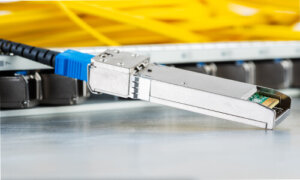Fiber’s established technology demands advanced access for evolving customer needs. Fiber-to-the-home/nodes are essential for triple/quadruple play, 5G, and broadband. GPON is the reliable solution, optimizing costs while delivering exceptional broadband through Superior quality of service (QoS),dynamic bandwidth allocation capabilities and flexibility.
What is GPON?
GPON stands as a prominent standard in Passive Optical Network (PON), a point-to-multipoint network technology that employs fiber optic cables to provide broadband access to end users. The term “Gigabit” in GPON signifies its maximum speed, typically offering downstream speeds of 2.488 Gbps and upstream speeds of 1.244 Gbps. This shared bandwidth results in access speeds beginning at around 10 Mbps. “Passive” indicates that the optical fiber network operates without reliance on electrically-powered equipment along its path.
Today, GPON has emerged as the predominant optical fiber connection, boasting nearly 95% greater energy efficiency than traditional copper cable networks. Notably, GPON achieves a 1:64 ratio on a single fiber, enabling a solitary cable to deliver video, data, and voice to up to 64 users. This makes GPON the optimal choice for efficient last-mile connectivity, reducing the need for numerous fiber runs.
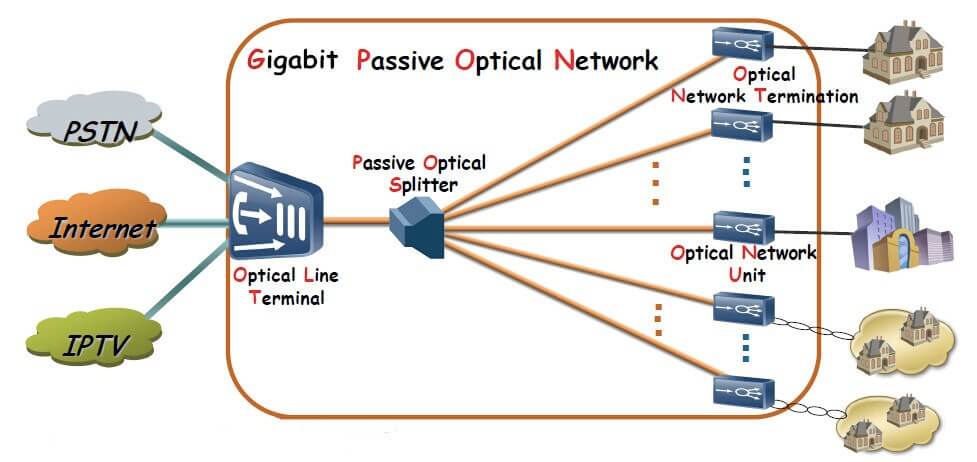
GPON’s distinctive feature lies in its use of Asynchronous Transfer Mode (ATM) encoding, allowing seamless integration of voice and data traffic on a single network. This technology excels in delivering triple-play services (Data, IPTV, VoIP) at higher data rates, extended bandwidth, and greater distances with enhanced security and data encryption. GPON supports various Ethernet protocols, employing block lengths of 128 bits and key lengths of 128, 192, and 256 bits. In summary, GPON proves invaluable in modern telecommunications, facilitating robust and secure connectivity for a multitude of services.
How does GPON Work?
With a grasp of GPON’s fundamentals, delving into its functioning is a logical step. Central to GPON’s operation is its point-to-multipoint access fiber optic network topology.
GPON is comprised of three primary components: an Optical Line Terminal (OLT), an Optical Network Unit (ONU) device, and a passive splitter. Notably, the passive optical splitter plays a pivotal role, enabling a single optical fiber cable to link the internet service provider with numerous end users. This splitter efficiently divides the signal into as many as 64 separate streams.
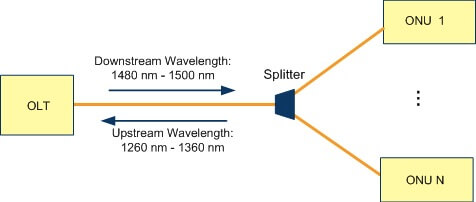
Want to understand the process flow? Here’s a simple breakdown.
Optical Line Terminal (OLT) Transmission
The Optical Line Terminal (OLT), usually operated by your ISP, emits data as optical signals using Optical Wavelength Division Multiplexing (WDM). It acts as the starting point of a GPON network.
Signal Propagation
The optical signal travels along a single fiber through the Optical Distribution Network (ODN), spanning up to 20 km, until it reaches the passive splitter at the end.
Passive Splitter Function
The passive GPON splitter receives the optical signal and divides it into multiple streams, potentially up to 64. This division facilitates point-to-multipoint access, allowing numerous fiber connections.
Last-Mile Connection
In the last leg of the journey, the divided optical signals arrive at individual GPON ONT/ONU devices. These devices are located on the premises of residences or businesses. At this stage, the optical data signal is converted into an electrical signal. Conversely, data is sent upstream from the GPON ONT/GPON ONU back to the OLT.
Let’s consider your Internet service provider’s Optical Line Terminal (OLT) as the starting point for the GPON system. Your ISP’s Internet, voice/telephone, and TV data services are transmitted from this point. The data travels through the single fiber optical distribution network (ODN) until it reaches the passive optical splitter. Once there, the splitter disperses the light signal into multiple signals, delivering them to individual ONT/ONU devices at your home or business for service access. These ONT/ONUs represent the endpoint(s) of the process.
The steps look like this: OLT sends one-point signal > ODN > splitter breaks into multiple signals > multiple ONT/ONUs receive signals. This is a simplified version, but it gives you a high-level idea of what is happening on a GPON system.
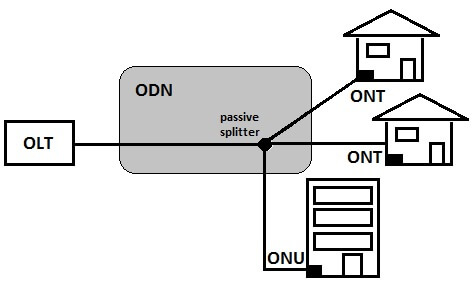
Components of GPON
Dive into the intricate workings of GPON components. The GPON standard, based on ITU-T recommendation G.984, comprises four key components.

Optical Line Terminal (OLT)
The heart of the Gigabit Passive Optical Network, the OLT oversees the network’s operation. It transmits and receives optical signals, including video, data, and voice, to and from the Optical Network Terminal (ONT) at the user’s end. Downstream signals are sent at 1550 nm (video) and 1490 nm (voice and data), while upstream signals are received at 1310 nm to prevent interference. Typically located at the service provider’s facility, the OLT converts optical signals to electrical ones, similar to the GPON ONT. It connects to the optical splitter through backbone cabling.
Optical Fiber Splitter
This passive component, the optical fiber splitter, divides a single fiber optic cable into multiple individual strands. These strands branch out to connect with individual Optical Network Terminals (ONTs) at end-user locations. Depending on requirements, GPON splitters can feature split ratios like 1:64, 1:32, 1:16, 1:8, or 1:4. They serve in centralized splitting (dividing signals among multiple users) or cascade splitting (connecting to further splitters for an extended network).
Optical Network Terminal (ONT)
The user’s interface with GPON, the Optical Network Terminal (ONT), functions as a specialized modem. It transforms optical signals into electrical ones at the user’s premises, granting broadband access to devices like WiFi, TVs, and desktops. Additionally, the ONT optimizes and aggregates data from the user back to the OLT.
Transmitting Media
The transmitting media encompasses the physical, passive hardware essential in the GPON infrastructure. This encompasses copper cables, fiber optic patch cords, splitters, connectors, and adapter panels. Transmitting media significantly influences and optimizes optical signal loss management throughout the network.
In summary, the GPON system’s prowess emerges from the orchestration of these four fundamental components. Each plays a distinct role, collectively delivering efficient and high-performance optical connectivity.
Advantages of GPON
The popularity of Gigabit Passive Optical Network (GPON) stems from a range of distinct advantages it offers.
High-Speed
Addressing the demand for speed, GPON ensures smooth traffic handling with up to 10/10 Gbps per subscriber and a 40 Gbps optical network throughput.
Security
GPON employs Advanced Encryption Standard for robust security, coupled with its isolated closed-circuit nature for secure optical fiber transmission.
Stability
GPON remains reliable even amidst congestion and heavy traffic. Steady connectivity is guaranteed through minimum bandwidth allocation to users and protection from electromagnetic interference due to fiber optics.
Space-Saving Technology
GPON’s single-cable approach reduces the need for multiple communication rooms and duplicated infrastructure, resulting in up to 80% reduced spatial requirements for cable pathways.
Energy Efficiency
Operating as a passive system, GPON consumes minimal electricity, showcasing energy efficiency and outperforming copper networks with a 95% energy reduction.
Future-Proofing
GPON’s fiber-to-the-room design obviates the need for complete network replacements with evolving technology. Recent advancements like NGPON2 and XGSPON ensure GPON remains ahead of end user bandwidth demands for several technology generations.
Cost-Effective
GPON’s low energy consumption leads to reduced operational costs, requiring minimal IT support. Its ability to connect multiple customers through splitter technology decreases equipment needs, making it a cost-effective solution.
In essence, GPON’s all-encompassing benefits, spanning energy efficiency, affordability, high speed, security, stability, space efficiency, and future adaptability, have cemented its position as a cutting-edge optical network technology.
Disadvantages of GPON
While GPON technology offers significant advantages, it also presents certain drawbacks that deserve consideration.
Fiber Optic Cable Vulnerability
A notable drawback of GPON technology is the vulnerability of fiber optic cables to physical stresses like bending, kinks, and breakage. Given their sensitivity, improper installation without careful handling and protection can lead to compromised performance or even cable failure over time.
Bandwidth Sharing Limitation
GPON technology involves splitting and distributing bandwidth among multiple users, which can be less optimal in a world increasingly reliant on high bandwidth. As multi-gigabit networks become commonplace, this approach may hinder the delivery of consistently high-speed connections.
In light of these disadvantages, it’s important to weigh the trade-offs between GPON’s benefits and limitations. Despite these drawbacks, GPON technology remains a valuable choice for many applications, providing reliable and efficient fiber optic connectivity to meet various needs.
GPON’s Evolution: From Market Growth to Optical Dominance
GPON’s popularity has witnessed a sustained rise, owing to its cost-efficiency and suitability for large-scale fiber optic cable deployments. In 2021, the global GPON market reached an estimated value of US$10 billion, with projections indicating a surge to US23.1 billion by 2032. Notably, over 250 million units of GPON products were shipped globally in 2021.
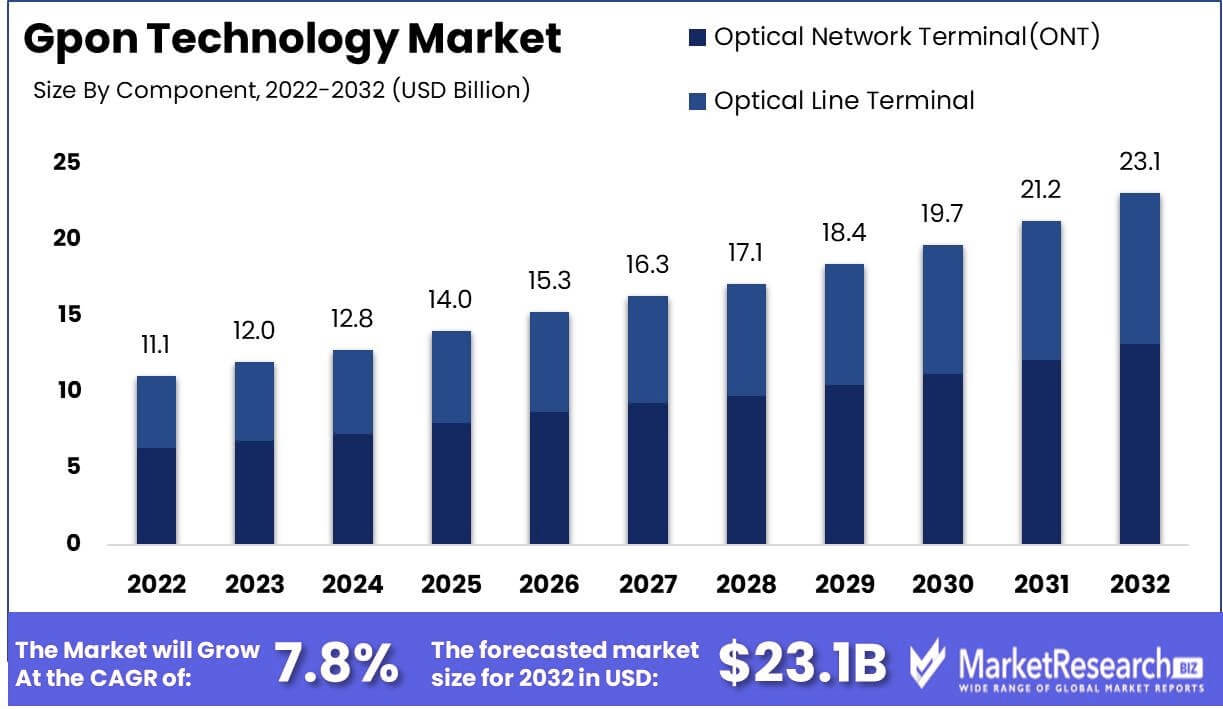
(source: https://marketresearch.biz/report/gpon-technology-market/)
This surge can be attributed to several factors, including the proliferation of bandwidth-intensive applications, the emergence of smart cities, widespread adoption of IoT technologies, the rapid expansion of 5G networks, and the utilization of GPON for mobile backhauling. These trends collectively highlight GPON’s significance and its anticipated role in future-proofing optical networks.
As the landscape evolves, GPON remains a preferred choice, poised to meet the escalating demands of modern connectivity. Furthermore, the anticipated emergence of upgraded iterations like NG-PON2 reinforces GPON’s relevance, cementing its status as the prime candidate for fulfilling the evolving needs of optical networking.
FAQs about GPON
Q: Is GPON a fiber?
A: No, GPON is not a fiber itself. It’s a type of Passive Optical Network architecture that utilizes fiber optics to deliver broadband access. The term “Gigabit” in GPON signifies its high-speed capabilities.
Q: Is GPON a modem?
A: No, GPON is not a modem. It’s an optical fiber network access architecture that uses passive splitters to distribute one optical fiber connection to multiple premises. An Optical Network Terminal (ONT) is used to convert the optical signal to an electrical one.
Q: How do I connect my GPON to my router?
A: To connect GPON to your router, you need to link the Optical Network Terminal (ONT) to the router using an Ethernet cable.
Q: How many times can you split GPON?
A: GPON can achieve a split ratio of up to 1:64 on a single fiber line. This means that a single optical fiber from the service provider can be split into up to 64 connections for end-users.
Q: What are the GPON standards?
A: GPON adheres to the ITU G.984 standard, which was developed to support higher data rates and provide better Quality of Service (QoS) compared to earlier PON technologies. GPON is compatible with existing access networks and has features like Dynamic Bandwidth Allocation (DBA).
Q: Where is GPON used?
A: GPON (Gigabit Passive Optical Network) is widely used in FTTH and FTTP networks to deliver high-speed voice, data, and video services. It is a standard for Passive Optical Networks published by ITU-T and provides last-mile fiber connections to premises, offering faster speeds and superior Quality of Service.
Q: How long will GPON meet your needs?
A: GPON has a robust future due to its advanced QoS and dynamic bandwidth allocation features. The ITU has designed next-generation PON standards to ensure smooth growth and prevent overlaps with existing capabilities, making GPON a reliable solution for evolving service provider needs.
Conclusion
GPON technology offers a multitude of benefits that cater to various needs, ensuring a superior user experience. With increased bandwidth capacity, both immediate and long-term cost savings, heightened safety, faster connectivity, energy efficiency, space optimization, and future-proofing, GPON excels on every front.
In today’s rapidly evolving landscape, investing in a network that can accommodate innovation and growth is crucial. GPON presents a solution that not only meets the present demands but also sets the stage for a future-ready cable network infrastructure.




